© 2012 Pearson Education, Inc. Chapter 11 International Debt Financing QUESTIONS 1. What are the three main sources of financing for any firm? Answ er: Corporations rely on three primary types of financing for their capital expenditures: internally generated funds, debt financing, and equity financing. 2. What is the difference between a centralized and decentralized debt denomination for a MNC? Answ er: Under a decentralized debt-denomination model, MNCs issue debt in different currencies to hedge the cash flows they earn in these currencies from their foreign subsidiaries. Under a centralized model, debt is issued in the currency of the country in which the MNC has its headquarters. 3. Will a MNC issuing debt in low–interest rate currencies necessarily lower its cost of funds? Why? Answ er: No. The ultimate cost of the debt will also depend on currency movements. If uncovered interest rate parity holds, the cost of the low interest rate debt, expressed in the home currency, is expected to be identical to the cost of high interest rate debt. After the fact, the debt will be either less expensive than corresponding debt denominated in the domestic currency, if the foreign currency appreciates less than predicted by UIRP; or it will be more expensive if the foreign currency appreciates more than predicted by UIRP. 4. Should a MNC borrow primarily short term when short-term interest rates are lower than long-term interest rates? Or should it keep the maturity the same but use a floating-rate loan rather than a fixed-rate loan? Explain. Answ er: First, if short-term interest rates are lower than long-term interest rates, this may be an indication of impending increases in interest rates. In f...


